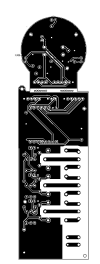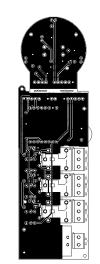Hello there,
I never worked with electronics or with programming, but few months ago I accepted the challenge, from my 8 years old son, to study and after teach him.
I already did some minor projects that worked very fine and we are enjoying each step.
My last project, perhaps, is becoming the greater challenge until then. Design a Smart Fan, with a button for switching between speeds, motorized oscillating system, IR control and, after all the previous items are done, voice control by alexa.
I was able to gain success on all the items (voice control is a bonus that I will pursue after the prime design is done), and the Breadboard version was fully functional. So I decided for a new step, PCB design, and everything worked like a charm (at least that is what I believe). Had minor tweaks to be done on the PCB, but mainly it was fine.
I was powering all the system using the USB port of the Wemos, in all the versions of the project, from the breadboard version up to the PCB version, and everything was fine. On the PCB version I included a 5V Hilink power source for the system, but all the primary tests were being done by the Wemos USB port.
But, when I finally powered the system with the Hilink... weird stuff happened.
It turned on. The controls worked, the leds lighted up as it should. The buzzer sounded the correct "beeps". But the relays weren't switching.
The design uses three relays where one is for each speed of the fan. It works, and I did several tests with the breadboard version, and everything was fine. The PCB version works also, and all the relays switch according to the design... but only when powered by the USB port of the Wemos. When it's powered by the HILINK, the remain silent.
double checked all the PCB tracks. The diagram also. Used a external spare hilink to power the system, inserting the 5v directly to the "Vin" of the wemos D1, and the problem persists.
Now I am out of options. How I am a Noob, I am sure that something simple has not been seen by me, but more experienced eyes may detect.
So here I am begging for help.
Below is the diagram of the design and the PCB board. If you need more material to analyse, let me know.
I never worked with electronics or with programming, but few months ago I accepted the challenge, from my 8 years old son, to study and after teach him.
I already did some minor projects that worked very fine and we are enjoying each step.
My last project, perhaps, is becoming the greater challenge until then. Design a Smart Fan, with a button for switching between speeds, motorized oscillating system, IR control and, after all the previous items are done, voice control by alexa.
I was able to gain success on all the items (voice control is a bonus that I will pursue after the prime design is done), and the Breadboard version was fully functional. So I decided for a new step, PCB design, and everything worked like a charm (at least that is what I believe). Had minor tweaks to be done on the PCB, but mainly it was fine.
I was powering all the system using the USB port of the Wemos, in all the versions of the project, from the breadboard version up to the PCB version, and everything was fine. On the PCB version I included a 5V Hilink power source for the system, but all the primary tests were being done by the Wemos USB port.
But, when I finally powered the system with the Hilink... weird stuff happened.
It turned on. The controls worked, the leds lighted up as it should. The buzzer sounded the correct "beeps". But the relays weren't switching.
The design uses three relays where one is for each speed of the fan. It works, and I did several tests with the breadboard version, and everything was fine. The PCB version works also, and all the relays switch according to the design... but only when powered by the USB port of the Wemos. When it's powered by the HILINK, the remain silent.
double checked all the PCB tracks. The diagram also. Used a external spare hilink to power the system, inserting the 5v directly to the "Vin" of the wemos D1, and the problem persists.
Now I am out of options. How I am a Noob, I am sure that something simple has not been seen by me, but more experienced eyes may detect.
So here I am begging for help.
Below is the diagram of the design and the PCB board. If you need more material to analyse, let me know.


